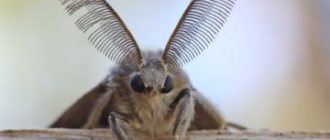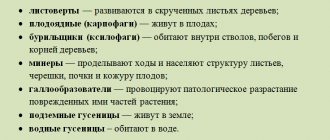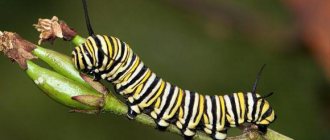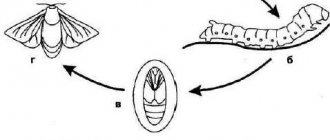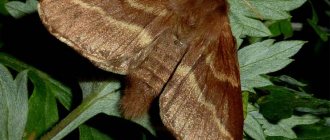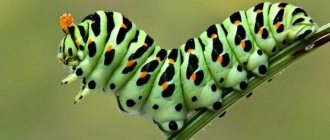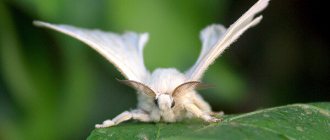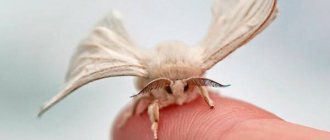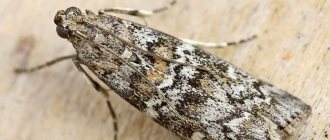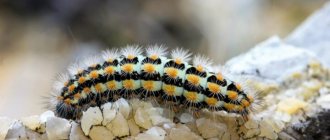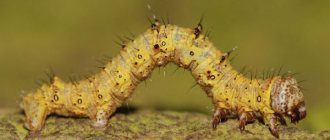A dangerous pest of forests and cultural plantings, the gypsy moth has a wide distribution area. This pest can be found in Asia, Europe, North Africa, and North America. It covers the entire territory of Russia, found in the south, Siberia and the Far East. Deciduous tree species are especially affected by caterpillars. In the absence of food, silkworms move to young coniferous trees. Once in the nursery, insects can cause significant damage to the plantings.
Description
Name: Gypsy moth Lat.:
Lymantria disparClass: Insects - Insecta Order: Lepidoptera - Lepidoptera Family: Erebids - Erebidae
| Habitats: | forests and vegetable gardens |
| Dangerous for: | oak, linden, coniferous, larch |
| Means of destruction: | collection, attracting birds, chemistry |
Some scientists believe that the name was influenced by the unpaired number of warts (blue - 6 pairs, red - 5 pairs). Female and male individuals have different sizes, wing shapes and colors.
The female is larger with a thick cylindrical belly. The pointed wings are gray-blue. The wingspan of the female individual ranges from 6.5 to 7.5 cm. The front wings have dark brown transverse lines. They rarely fly.
Males are yellow-brown in color. They have a thin abdomen. The wingspan is no more than 4.5 cm. The front wings are gray-brown in color with jagged transverse stripes. The hind wings have a dark edge. Males are very active and can fly far.
Female and male gypsy.
Silkworm caterpillar
The larvae are 5–7 cm in size. The color is gray–brown. The back has three narrow longitudinal yellow stripes. There are 2 longitudinal black spots on the head. The warts of an adult caterpillar are blue and bright burgundy with sharp and hard hairs. When they come into contact with the human body, they cause irritation and itching.
Gypsy moth caterpillar.
Fighting methods
There are many effective methods to protect the garden from gypsy moths. The choice of the appropriate one depends solely on the degree of damage to the tree and the size of the pests. So, in case of minor damage to the tree, it is enough to simply collect the egg clutches (caterpillars) of the pest. It is necessary to carefully examine the entire tree (shrub) and, if caterpillars are found, carefully collect them (don’t forget to wear gloves) in polyethylene and then crush them. We do something similar with masonry. The only thing that needs to be done is not to collect it, but to scrape it from the surface of the tree into some kind of bag or box and then destroy it.
Carry out preventive measures in spring and autumn
The next method of pest control is traps. You can build traps from special glue rings for caterpillars, placing them on a tree trunk, or you can make effective traps with your own hands from burlap. At a height of about 1.5 m, wrap a piece of burlap about 30 cm wide around the trunk and secure it. Pull it partially down, holding the top part with your fingers. And every day, “armed” with gloves (sufficiently thick) and a bag, collect and destroy the caterpillars.
Advice. If you live in a region where the gypsy moth is widespread, try to further protect yourself by planting bushes/trees in your garden that the pest avoids: black/gray walnut, ash, dogwood, etc.
If, after doing all of the above, you were unable to get rid of the pest, you can move on to the “heavy artillery”: biological and chemical agents. The former are most often presented in the form of bacteria that enter the pest’s body with food. As for chemicals, they are used extremely rarely and in moderate quantities.
This concludes our consideration of the issue regarding the destruction of gypsy moths on the site. Have a good fight!
History of the pest
Gypsy moth caterpillar.
The gypsy moth appeared on the continent in late 1860. A French naturalist wanted to cross the domesticated silkworm, which produces silk, with a gypsy moth. His goal was to find disease resistance. However, this did not work out.
Having released several moths, they quickly multiplied and began to inhabit all the surrounding forests. Thus, insects settled throughout the American continent.
Caterpillars are able to overcome forests, fields, and roads. Even eggs on the wheels of carts and cars can travel. Insects are populating more and more new countries.
Damage caused
The gypsy moth is a typical forest pest. Gypsy grass caterpillars heavily eat the foliage of plants and cause significant damage not only to wild trees and shrubs, but also to gardens and fruit crops.
The gypsy moth is characterized by periodically occurring outbreaks of mass reproduction, during which the caterpillars settle over large areas. These outbreaks are often protracted. During the years of mass reproduction of the gypsy grass, its caterpillars can completely expose forest areas and plantings of fruit trees, eating away the foliage. This often leads to trees drying out.
Argasid mites are typical carriers of encephalitis and borreliosis pathogens. Ants are very interesting insects. See for yourself by reading our article.
"Nissoran" effectively helps in the fight against herbivorous mites. How to use this drug correctly, read the link.
Species of gypsy moth
There are such varieties:
- ringed - miniature, the wings of females are 4 cm in size, males - 3 cm. The caterpillar reaches 5.5 cm. It has a gray-blue color. They inhabit Europe and Asia;
- traveling – caterpillars migrate to new feeding areas. The leader of a long chain throws out a silk thread and everyone else follows him;
- The pine cocoon moth is an inhabitant of the coniferous forests of Europe and Siberia. The female is gray-brown in color. Size 8.5 cm. Male – 6 cm. Very damaging to pine;
- Siberian - dangerous for spruce, pine, cedar, fir. Color can be black, gray, brown.
Preventive measures
In order to prevent the possibility of the pest appearing on your site, take timely preventive measures to care for trees:
- In the autumn, you should periodically carefully inspect all the trees in the garden and even the fence of the area for the presence of egg clutches about 3 cm long. If clutches are found, they must be carefully scraped off and crushed.
- With the onset of winter, you need to be especially vigilant if the weather is mild. The fact is that a mild winter, along with the warm and dry spring that replaces it, can create almost ideal conditions for the pest.
- In the spring and summer, carefully inspect the tree foliage: there should be no holes on its surface. If you find them, place sticky tape near the damaged leaves to confirm the presence of silkworms. If concerns are confirmed, use a special product to combat this pest.
Advice. If a silkworm has damaged the foliage of a tree and its growth has slowed down, do not rush to uproot it. It is important to wait until next spring and only remove it from the site if the tree shows no signs of life.
Stages of development
Stage 1
The egg is smooth and round with a pinkish or yellowish color. By autumn, the larva develops and overwinters in the egg shell.
Stage 2
In spring the larva is released. Her body has numerous long black hairs. With their help, the wind carries them over long distances.
Stage 3
The pupation period occurs in mid-summer. The pupa is dark brown with a tuft of short red hairs. This stage lasts for 10 – 15 days.
Stage 4
Eggs are laid in heaps in the bark, on branches and trunks. The ovipositor is similar to a soft and fluffy round pad. Mass reproduction of the insect looks like yellow plaques. They can cover the entire underside of horizontal branches. Also, such places can be stones, walls of buildings, containers, vehicles.
Reproduction
The process of reproduction and development of the gypsy plant includes several stages.
Mating and egg laying
Gypsy moth butterflies emerge from their pupae in July and August, first males, a little later - females. They fly low above the ground in the evenings, find partners and mate.
After mating, each female lays from 100 to 300 eggs on trunks, branches or tree roots protruding from the ground.
Larval development inside the egg
The eggs of the gypsy are smooth, round, slightly flattened on top. The female covers the clutch with hairs from her abdomen to give it a dark to light brown color. Most of the eggs laid overwinter above the snow cover and are exposed to low temperatures, which does not lead to their death.
Caterpillar stage
Caterpillars hatch from eggs at an average daily air temperature of 4–16 °C; usually their appearance coincides with the beginning of the growth of leaves and needles on the fodder trees.
The caterpillars actively feed for 2–2.5 months, after which they gather on trunks, branches, in the crowns of trees and shrubs and pupate.
Pupa stage
Gypsy moth pupae are dark brown or matte black in color. They are covered with sparse tufts of short brown or red hairs. The length of the pupae is from 18 to 37 mm.
Pest diet
Insects are very unpretentious in nutrition. They can consume about 300 species of trees.
They feed on the leaves of trees such as:
- birch;
- oak;
- Apple tree;
- plum;
- Linden.
Caterpillars do not feed:
- ash;
- elm;
- Robinia;
- field maple;
- honeysuckle.
The larvae eat small shrubs and conifers. They are particularly gluttonous. But most of all, oak and poplar leaves give the gypsy moth vitality and fertility.
Geographical distribution
The habitat of the gypsy moth is all of Europe to the southern regions of Finland and Scandinavia, as well as North America, North Africa, Japan and the countries of Asia Minor.
In Russia, the pest is widespread in the south and throughout the territory where oak grows.
It is also found in Siberia, the Baikal region (55–57° north latitude), and the Far East.
The ringed silkworm is distributed in Europe, with the exception of the Far North, in South and North Korea, Japan, and northern China. In Russia, it lives in the Far East and Siberia.
Attention and disguise
The bright coloring of the wings helps butterflies to see each other from afar, facilitates the meeting of males and females, and shows rivals that the territory is occupied. But at the same time, it attracts predators. Therefore, in many species only the upper side of the wings is bright, and the lower side imitates the color of soil, tree bark, dry leaves or other inedible objects.
Kallima butterfly
The Indian Kallima has achieved particular success in this kind of camouflage, the underside of which is similar to a dry leaf not only in color, but also in shape - a special growth in the lower part of the wing even imitates the petiole of a leaf.
Dipper Butterflies (Arctiidae)
Butterflies that are poisonous or have an unpleasant taste or smell for predators do not camouflage. Such, for example, are our bears (Arctiidae) and South American heliconiuses (Heliconidae). Their pattern on both the upper and lower sides is a contrasting combination of red, black and yellow stripes and spots. Fast predators remember for a long time the unpleasant sensations delivered by poisonous prey.
Imitation
Whitefish Pieridae
Some species, being absolutely edible for many hunters, imitate poisonous ones in color. For example, the same heliconius is almost completely copied by some species of whitefish (Pieridae). Others, such as glassworts (Sessiidae), copy equally well-protected wasps. For example, a poplar glass beetle is very similar to a hornet in size, color, body shape, and even the way it folds its wings, which, like all glass bees, which is why they got their name, are transparent. A group of species of small hawkmoths with transparent wings, like those of the glass moths, are called bumblebees, because these butterflies copy bumblebees in color.
Meaning in nature
Gypsy moths are malicious forest pests. They completely destroy the foliage, leaving the plant to die. Moreover, it is not only the wild forest that suffers losses, but gardens cultivated by people and personal plots with fruit-bearing trees. This order has one distinctive feature: it is characterized by periodic outbreaks of fertility and mass migrations. Due to this, damage is caused to large areas. Very often such events are of a long-term nature. In order to assess the scale of the lesions, look at the photos; there are a lot of them on the global network, so the search takes just a few minutes.
Natural enemies
In nature, the enemies of the silkworm are:
- birds (the sparrowhawk especially likes the silkworm);
- insectivores that eat larvae and butterflies (for example, they are a treat for squirrels);
- parasitic insects (for example, these are hedgehog flies or tahini, which lay eggs in the body of the silkworm);
- pathogens (eg pebrina).
Sericulture involves human struggle with the deadly enemies of the silkworm.
Silk industry
Breeding silkworms to produce silk cocoons - the raw material for making natural silk - is called sericulture. This craft began to be practiced in China several thousand years ago. The ancient Chinese valued silk very highly for its strength, softness and shine. The silk thread is extremely thin - 0.022-0.04 mm in diameter, but is strong and can withstand a weight of 15 g without breaking.
By the beginning of our era, sericulture came to Central Asia, and from the 2nd century. Silk began to be imported to Europe, but Europeans managed to open their own production only in the 6th century. under Emperor Justinian. Legend has it that two missionary monks brought grena to Constantinople, hiding it in their hollowed staves. Silkworms were fed black mulberry leaves, although they prefer white ones. Subsequently, sericulture in Europe developed slowly but surely. Today this technology has long been proven throughout the world.
Silk "incubator"
How silk is obtained
The silkworm caterpillar makes a cocoon for itself from silk thread, therefore, in order to obtain silk, the silkworm is kept (incubated) in special rooms where the best conditions are created for it. Incubation is calculated so that the caterpillars appear simultaneously with the first leaves on the mulberry. After the caterpillars emerge from the greens, they are transferred to other rooms, where they are fed with cut mulberry leaves and young shoots. In a month, a silkworm eats twenty times its own weight in leaves. Then, as it should be in nature, the caterpillar begins to produce silk thread and builds a cocoon. One individual produces up to 15 cm of mulberry per minute, and in a cocoon there is up to 900 m of it. At this point, its development is stopped: the cocoons are boiled, the butterfly inside dies, and the thread is used to produce silk fabric.
Not all cocoons are used for the production of silk thread. Many of them are left for further breeding of butterflies, which will then lay eggs
Ancient Craftsmanship
Since ancient times in the East, silkworm cocoons have been processed as follows. They were poured with boiling water and kept for 2-2.5 hours to remove the sticky substance that strengthens the cocoon. After this, the fibers were not so difficult to unwind and begin to form threads. A thin thread was made from 5-6 fibers, and a thick one from 25. Ready-made skeins of thread were delivered to special workshops, where they were dyed and then sent for weaving.
Cocoons under the influence of boiling water
In Thailand, as in China, sericulture has been practiced for many centuries. It is not surprising that this country manages to export natural silk fabric of the highest quality
Nutrition
The gypsy moth butterfly has no mouthparts and does not feed at all, and the caterpillars are very voracious and polyphagous. In different habitats, gypsy is associated with different species of trees and shrubs.
The main food items for caterpillars are:
- in Europe, the Caucasus and the Far East - various types of oak;
- in the mountain forests of the Caucasus, Crimea and Carpathians - hornbeam and beech;
- in forest-steppes and small-leaved forests of Siberia - birch and aspen;
- in the mountain forests of the Urals and Sayan Mountains - various types of larches;
- in the mountains of the Altai Territory - larch, fir, pine and cedar;
- in the mountains of Central Asia - fir, spruce, pear and maple.
Caterpillars that have recently hatched from eggs feed mainly during daylight hours, while they migrate within the crown. Older caterpillars feed primarily at night, especially in persistent warm weather.
